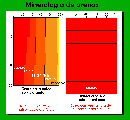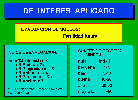
Sand minerals are a stable fraction that is only
altered very slowly. In spite of representing a quite inert and
not very chemically active material, they are considered to be
very interesting from the point of view of agricultural use. This
is due to that fact that sand minerals, as they alter slowly,
represent the future fertility of the soil. Therefore, determining
the sand mineralogy is an effective measurement of natural reserves
in the soil.
The following table lists sand minerals from the point of view
of the possibilities of providing the soil with nutrients. The
most interesting minerals will be those that have some specific
nutrients in their structures and which have a high to average
alteration velocity (for example, pyroxenes and amphiboles). On
the other hand, we have quartz as a representative example of
a very stable mineral, which also has a chemical composition that
has no interest from a nutritive point of view.
|
NUTRIENT ELEMENT* |
MINERAL |
ALTERATION VELOCITY |
|
K |
Potassium feldspar |
low |
|
K |
Muscovite |
low |
|
K |
Biotite |
average |
|
Ca/Mg |
Plagioclases |
average / high |
|
Ca/Mg |
Amphiboles |
high |
|
Ca/Mg |
Pyroxenes |
very high |
|
Ca/Mg |
Serpentines |
average |
|
Ca/Mg |
Chlorites |
low |
|
Ca/Mg |
Carbonates |
very high |
|
P |
Apatite |
very high |
|
Fe |
Oxides and hydroxides |
variable |
|
Mn |
Oxides and hydroxides |
variable |
|
Bo |
Tourmaline |
very low |
Any planning of the use of soils in a specific
region should go hand in hand with a mineralogical study of sands,
as this would help us to determine which types of soils should
be preserved (regardless of their current fertility) so that do
not become exhausted in the near future.
For example, the following figure shows the mineralogy of two
soils, with very different exploitation possibilities.

Bearing in mind both the fact that alteration is easy and the released elements (as shown in the previous table), it is possible to develop formulas to assess the future fertility of the soils on the basis of sand mineralogy.
